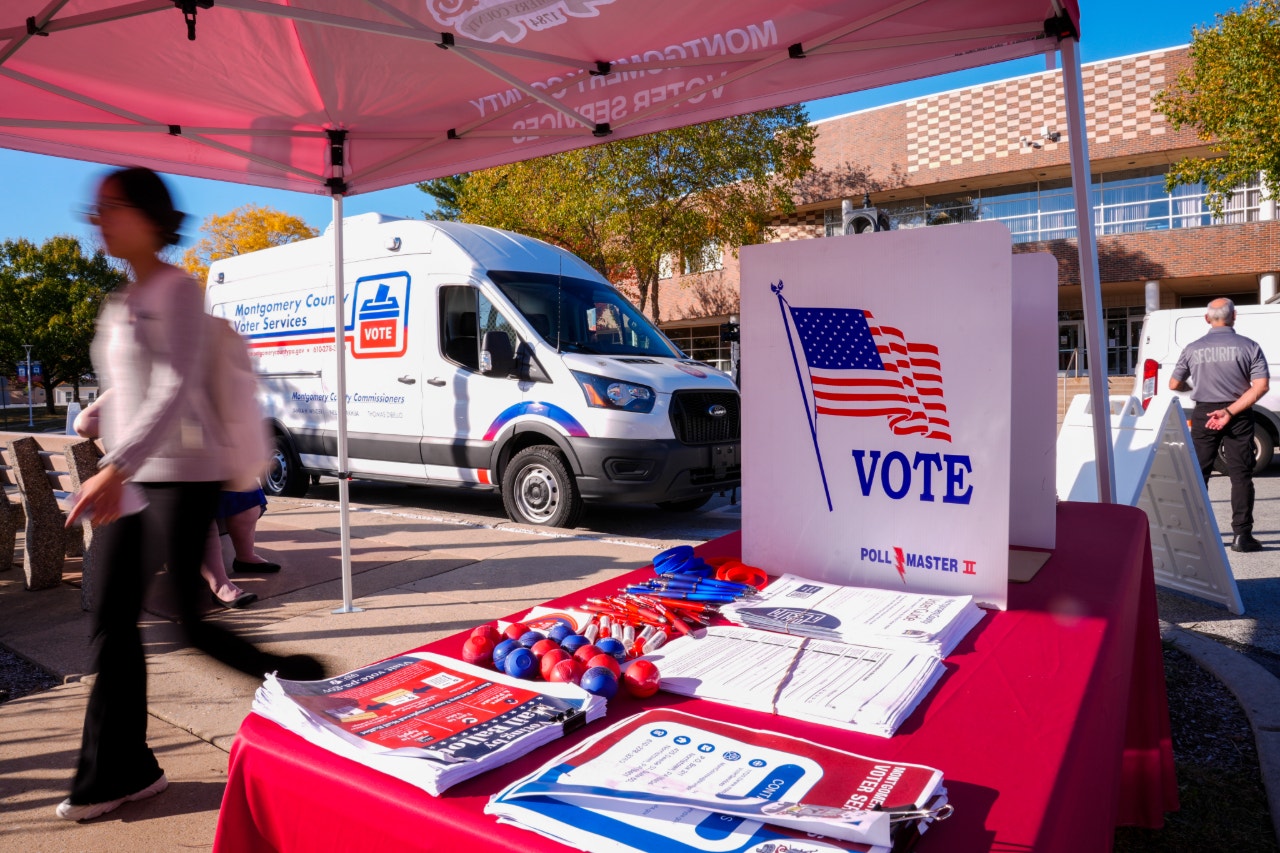This investigation was co-published with the Project On Government Oversight.
On the weekends, Aubrey Metzler lets out her frustration with military housing by screaming at strangers in the haunted house where she works, playing the part of “lunatic.” The 23-year-old mother of two has good reason to feel a little unhinged.
Metzler says her whole family has been sick ever since they moved into privatized military housing last spring on Fort Campbell, an Army base straddling the edge of Kentucky and Tennessee. Her 17-month-old son is so congested that he has trouble breathing. Her two-year-old daughter often complains of headaches and stomach pain, and both kids can’t use the tub in the upstairs bathroom without breaking out in hives. Her husband, an Army Private First Class, has recently been hospitalized for cluster migraines. Metzler herself throws up “every single day,” and describes the family’s housing challenges in a gravelly voice that’s punctuated by coughs and sniffles. On top of all that, the stress over housing has taken a toll on Aubrey and her husband’s mental health, she says, comparing her time working at the haunted house to “therapy.”
Metzler thinks the cause of her family’s health problems is mold, but she says it’s been an uphill battle getting taken seriously. Military family housing at Fort Campbell is run by Campbell Crossing LLC, a development of the global real estate conglomerate Lendlease.
“Every time they tell me there’s no mold, I find mold. Every time without fail,” Metzler says. A spokesperson from Lendlease said the company complies with Army guidance, and emphasized that the safety of military families is the company’s top priority.

Mold is among the most common — and most harmful — military housing issues around the country, according to advocates from organizations that have worked with thousands of families in situations like Metzler’s. But a gap in federal mold standards has been exploited by the military and housing companies to avoid testing and competent mold remediation, according to military housing advocates, attorneys, and experts interviewed by the Project On Government Oversight (POGO).
Editor’s picks
Newly obtained internal documents reveal just how bad the problem is, and the military’s efforts to contain it both within homes and in the court of public opinion. “Can we reframe the ‘problem’ as just a part of life?” reads a presentation slide from an Army counter-mold workshop held in early 2023. The workshop detailed a multi-faceted plan termed “OPERATION COUNTER-MOLD,” for improving conditions — and public sentiment — on mold issues in the nation’s largest military branch.
But mold woes are not unique to the Army, nor are they limited to specific housing companies.
Nearly all of military family housing has been privatized, run by companies that have been called “slumlords” amid a series of recent scandals around deplorable conditions, fraud, and a wave of lawsuits by service members demanding accountability.
Not to be confused with barracks — which are comparable to dorms and typically run by the Department of Defense (DOD) — privatized military family housing tends to be single-family homes. Approximately 700,000 service members and their families live in these homes, run by 14 companies in the U.S. across 78 developments. Several housing companies have been implicated in fraud schemes in recent years, including one that pled guilty in 2021 to defrauding the U.S. military of millions through falsifying home maintenance records, and another that paid a $500,000 settlement with no admission of guilt in a similar federal fraud case in 2022.
Related
While the military knows it’s a big problem when property managers fail to address mold, the lack of standards may obscure both the true extent of the damage and the dire impacts it wreaks for military families. Standards for mold could apply to prevention, identification (which could entail testing), or remediation (efforts to remove existing mold).
Plus, the fundamental nature of privatized military housing makes these situations harder for military families to escape. “They end up being trapped,” said Ryan Reed, a Texas-based attorney who specializes in military housing.
Service members typically have to move every couple years, often into unfamiliar communities where they may not have any support structure outside of the military. This frequency of moving can make it hard for military spouses to have steady employment to provide supplemental income. In most cases, military families have the choice of living on or off-base, though experts and advocates have cautioned that in some competitive housing markets, living off-base may not be a real option: It can be cost prohibitive on a military salary, or have insufficient options for schools or child care. When service members live in military housing, their rent is automatically deducted from their salary and sent to the housing company. Unlike in civilian housing, families in privatized military housing don’t have the ability to withhold rent when they have a problem in their home that their landlord needs to address, unless they enter into what is known as a “formal dispute process,” a congressional oversight fix that has a host of problems all its own.
Aubrey Metzler says they can’t afford to live off-base, nor can they afford the cost of child care. “We’re barely making it,” she said. “We are constantly stressed about the kids being in a house that is making them sick, and then feeling bad because we cannot afford to live anywhere else.”
The “Number One” Issue
Jason and Sarah Kiernan’s two-month-old son was emergency airlifted to the Dell Children’s Medical Center in April 2019, struggling to breathe. Days after returning home to Fort Cavazos, another son stumbled through a damp wall, revealing a hidden danger: The home was filled with toxic mold. Now five years old, their youngest son will likely need lifelong care because of a range of conditions connected to oxygen deprivation during infancy — conditions that the Kiernans linked to mold exposure in their lawsuit against the company. After a long legal battle, the Kiernans recently won an unprecedented $10.3 million settlement, with an arbitration panel finding that the housing company had misled the family about mold in the home.
The housing company in the Kiernans’ case was Lendlease, the same private business that oversees housing at Fort Campbell where Metzler lives. Lendlease announced that it was planning to sell off its U.S. military housing portfolio just days before the announcement of the Kiernans’ settlement was made public.
While the Kiernans’ legal victory was rare, their problem is less so.
Mold is the “number one” housing issue that military families face, according to Jean Coffman. She would know — she’s the executive director and board chair of the Safe Military Housing Initiative, an advocacy group that works with military families around the country. Coffman said mold tops the list both in terms of sheer numbers, and the potential for devastating harm to the families through health and economic impacts. Reed said roughly 90 percent of his military housing cases involve mold.
Mold was also number one when it came to tenant complaints in both Marine Corps and Navy housing in fiscal year 2019, according to a DOD report to Congress that was obtained by POGO through a Freedom of Information Act request. Mold encompassed 61 percent of Marine Corps complaints and 29 percent of Navy complaints in the report, which did not include similar data for the other military branches. More recently, DOD Secretary Lloyd Austin revealed in a letter to Senator Elizabeth Warren (D-Mass.) that in 2023 there were at least 4,588 reports of mold in Air and Space Forces privatized housing.
There have been more than 20,000 mold-related work orders in Army buildings since October 2022, with more than 1,000 work orders currently open, according to a spokesperson from U.S. Army Installation Management Command. That number encompasses military family housing, barracks, and other Army facilities. Although the spokesperson confirmed that the Army has far more detailed data on mold-related work orders and maintenance costs, including for military family housing specifically, they declined to provide additional data or to provide a narrower range than “more than 20,000.” The DOD and other military branches have not responded to our requests for interviews and mold-related data.
The full health impacts of this problem are unknown, in part because the Pentagon isn’t tracking whether housing conditions are making military families sick, according to a 2022 report by the DOD Office of the Inspector General.
Medical evidence links mycotoxins (the toxins produced by some molds) to a range of health conditions, including respiratory issues, flu-like symptoms, birth defects, immunosuppression, and cancer. Studies have also found a connection between mold and a number of mental health issues, including depression, anxiety, and “brain fog.” Infants and young children are even more susceptible to mold, with increased risk of asthma.
“There are growing numbers of us who are really worried of what happens when these children are exposed early on,” says Dr. Pejman Katiraei, a pediatrician who specializes in mold exposure.
Hiding Behind the Lack of Standards
Dallas Vann-Jones shares a wall with Aubrey Metzler in their duplex at Fort Campbell and can commiserate with her neighbor’s housing issues. Vann-Jones’s whole family is sick too (she has a three-year-old son and a seven-year-old daughter), and she says they have had a hard time getting the housing company to even acknowledge whether mold exists in the house, let alone help with getting rid of it.
“They just gaslight you,” Vann-Jones said, explaining how she has voiced concerns about mold in the house since January 2024 and was repeatedly told by housing company staff that there was no mold. “I literally sat on my couch and I bawled, ‘You are telling me there is no mold here, but my body is telling me otherwise, my children’s bodies are telling me otherwise,” she said.
Both Metzler and her neighbor say that they have been repeatedly denied requests for mold testing in their homes.

Housing companies and military branches often use the lack of a federal mold standard by the Environmental Protection Agency to justify refusing to test for mold in military homes, according to Coffman. In the Kiernans’ case, court filings indicate that positive test results for mold were the turning point when the family was relocated from the house.
“The reason we have successes for getting families displaced and for mandating certain protocols is because we’re holding the card that says, ‘Here are the tests,’” Coffman said.
Official documents by the Army, Navy and Marine Corps Public Health Center, and Air Force caution against the use of mold testing, pointing to a lack of federal mold standards. But even though there isn’t a federally established threshold for safe levels of mold, additional documentation by the EPA and some military branches do suggest situations in which testing should be conducted, such as when there are medical concerns linked to exposure — a nuance that may get lost in communications with military families.
“Many, many times our families push for mold testing,” said Heather Hall, founder and chief executive officer of the Military Housing Coalition, a military housing advocacy group. “That’s always thrown out as a no.”
It is not Army policy to refuse to test, according to an Army spokesperson. The spokesperson said that the leadership of Army installations have trained and certified mold inspectors, and that they follow the Army Public Health Center’s guidance.
“We are very, very focused on providing that safe, affordable housing for those soldiers and family members, and our command takes this extremely seriously,” the Army spokesperson said.
The Army’s guidance isn’t as thorough as the most widely used industry standard in the U.S., according to Michael Rubino, an air quality expert and the co-founder of the Change the Air Foundation, a national air quality advocacy organization that is pushing for improved federal mold policies.
Rubino has extensively reviewed the Army’s mold guide as an expert witness in a legal case, and cautioned that in that housing case, the management company had failed to follow important elements of the Army’s guidance. “It’s equally as important to ensure the staff in charge of property management are educated and trained properly on the standards and ensure that the standards are being adhered to,” he said. Rubino’s organization points to the need for improved standards not only when identifying the problem, but also through requiring that remediation be conducted by accredited professionals.
The lack of a mold standard is a widely used defense tactic for military housing companies in lawsuits brought by families, according to Reed, with some housing companies even citing language from the military to discredit the use of tests.
“I can go and do a two hour course and now be a mold inspector,” said Katiraei. This is a problem in military housing, advocates say, which can result in incompetence by contractors hired to deal with mold.
A spokesperson for the U.S. Army Installation Management Command said that their mold mitigation specialists receive two hours of training, but emphasized that approximately 80% of these individuals have also received an OSHA Mold Inspection Certification. The spokesperson said there are approximately 280 mold mitigation specialists for the Army in total, across family housing, barracks, and all Army facilities — Army family housing alone encompasses roughly 87,000 housing units worldwide. The spokesperson said they have the goal to have at least four OSHA certified specialists on each Army installation.
“The techs are not properly trained to identify mold,” Hall argues. “They come in, they misspeak. They will say, ‘mold is everywhere.’”
While a handful of states do have mold standards codified in law, whether they apply on military bases within those states is another question, because of the federal enclave doctrine, a legal defense used to exempt military housing from the protections of some present-day state and local laws.
The Mold “Communication Playbook”
In January 2023, more than 100 participants gathered at Army Installation Management Command headquarters for a “counter-mold” workshop, focused on educating Army “stakeholders” about mold issues in the nation’s largest military branch. The workshop covered strategies and practices for mold identification, prevention, and mitigation. It also included ample guidance for how Army officials should be talking about mold with the public, referencing a 2023 “Counter-Mold Communication Playbook,” campaign talking points, and social media campaigns.

An Army spokesperson emphasized that education of military families is a critical piece of their work countering mold, whether it be through face-to-face interactions or social media, “because obviously we hope we can stop any mold issues before they start.”
“Viewing mold as a normal part of life will decrease anxiety and increase trust,” reads one slide. Another claims, “mold is ubiquitous, its [sic] everywhere.” Yet another slide simply states, “MOLD IS MOLD,” while specifying that the Army’s “Mitigation Working Group” decided not to define what counts as “hazardous mold” because all “visible” mold should be mitigated. Coffman says she hears messaging like this all the time when working with military families, and not just from the Army, but across the military branches.
That framing is “just ignorance,” according to Joseph Reiss, an expert in mold remediation. Reiss has been working with Coffman’s organization on a pilot project intended to model how military and housing companies should respond to mold, and pushing for Congress to implement federal mold standards. So far, Reiss has conducted mold sampling at 22 military homes. Not all molds hold the same health risks for families, which is why he says testing is so useful. “The goal here is, test: Don’t guess,” he said.
Coffman singled out one military housing company that’s holding itself to a higher standard: Corvias, which recently announced it was seeking certification by the International WELL Building Institute, an organization that sets standards for commercial and residential environments — including for mold.
Lawmakers are aware of the issue and taking some strides to address it, but Coffman says more strenuous response is needed. If passed, a proposed amendment to the 2025 National Defense Authorization Act would require a study on the health effects of mold in military housing and new mold standards. Senators Raphael Warnock (D-Ga.) and Ted Cruz (R-Texas) also recently introduced legislation to improve DOD transparency in reporting on military housing conditions.
A February 2024 DOD memo identified plans for adopting “livability standards” that could apply to family housing, including those for indoor air quality. But that same memo touts the “higher quality” of privatized military family housing in terms of tenant satisfaction, and suggests the Pentagon may move to privatize barracks as well.
Trending
For now, Aubrey Metzler is still stuck in housing where her family feels unsafe. She says the mold the housing company treated in the bathroom this summer has come back, and she recently discovered mold in her dishwasher. She has also noticed mold growing quickly on fabric items in the home. A couple weeks ago, she said the housing company told her they were going to conduct some tests after all, but they still haven’t indicated when that will happen. In the meantime, it’s stressful to stay in a home that she worries is making her children sick.
“I cry a lot, because my daughter constantly tells me she doesn’t want to be here,” Metzler said. “She doesn’t feel good here, and I can’t do anything about it.”

 2 hours ago
1
2 hours ago
1
















.png)

.png)
.png)
.png)












 English (US) ·
English (US) ·  Hindi (IN) ·
Hindi (IN) ·